MEA Snack Food Market Size
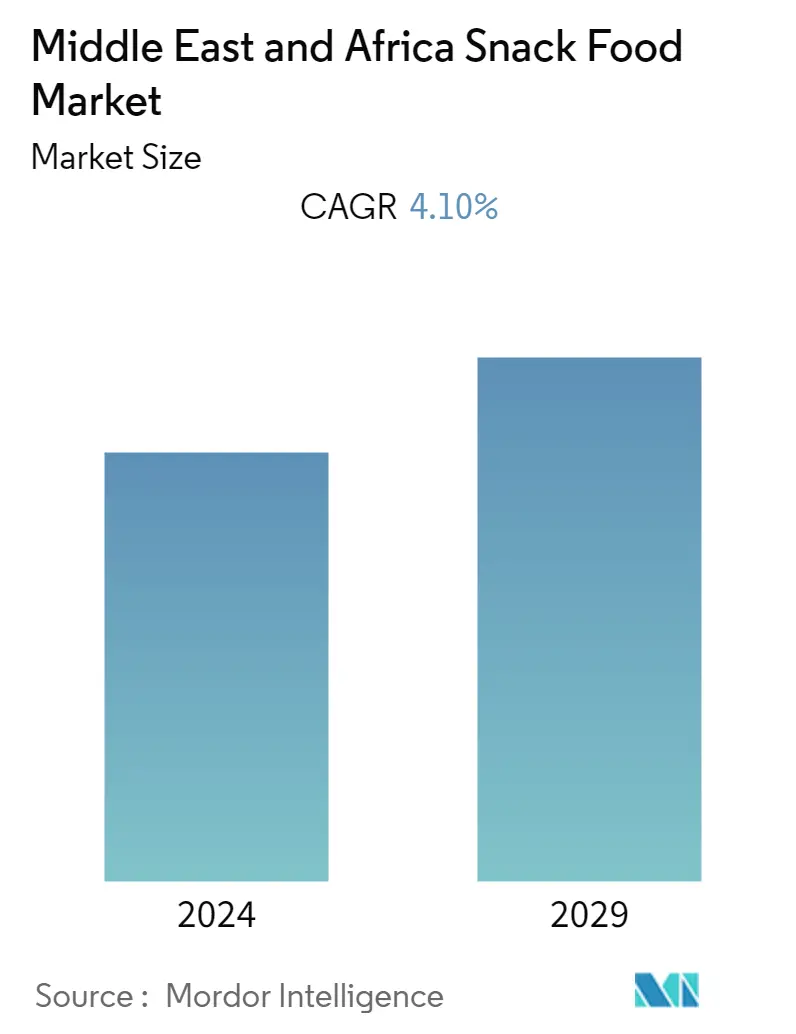
| Study Period | 2019 - 2029 |
| Base Year For Estimation | 2023 |
| Forecast Data Period | 2024 - 2029 |
| Historical Data Period | 2019 - 2022 |
| CAGR | 4.10 % |
| Market Concentration | High |
Major Players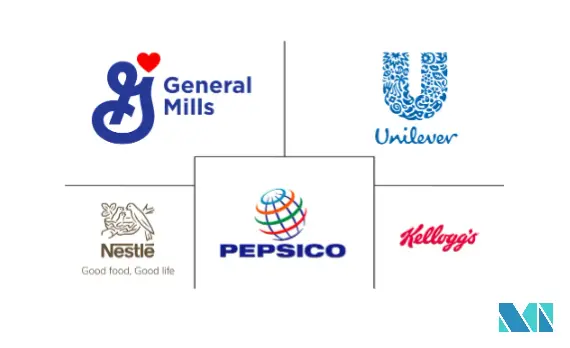
*Disclaimer: Major Players sorted in no particular order |
MEA Snack Food Market Analysis
The Middle East & Africa Snack Food Market is projected to register a CAGR of 4.1% during the forecast period, 2022-2027.
The consumer preference for nutritious and healthy snack food on a regular basis is driving the market. In addition, the robust growth of supermarkets and convenience stores that promote brand visibility is driving the growth of the snack foods market. Snacking is gaining traction in the middle east region during social occasions and the healthier snacking options are becoming more popular as customers become more informed. The region places the greatest emphasis on convenience combined with health benefits. Snacks often include bars with wholegrain wheat and other cereals, although pulse flours, nuts, and organically processed grains are also being used.
Innovative product launches with clean label ingredients are the major strategies adopted by the players in the market. For instance, In 2020, Bake Natur.ly, a 'better snacking' division of Dofreeze LLC and a Dubai-based business, announced the launch of its new muffins, available in Banana with Oats and Chocolate with Oats and White Chocolate Chips flavors.
However, the addition of artificial colors and artificial spices are considered to be unhealthy, leading consumers to have less consumption of excess salty or sweet snacks. Besides this, the growing obesity rate further induces consumers in the middle east to avoid fried, oily snacks, causing hurdle in the market growth of the product.
MEA Snack Food Market Trends
This section covers the major market trends shaping the MEA Snack Food Market according to our research experts:
Surging demand for clean-label and free-from snacks
There has been a significant increase in the demand for natural/organic food products, including snack bars, among consumers in recent years. This is due to the increasing awareness of the adverse health effects associated with consuming various synthetic food ingredients used in non-complying quantities in food products, as per government standards.
The snack food business in the United Arab Emirates is booming as consumers become more health-conscious and develop more nutritious snacking options, which are becoming increasingly popular. As snack bars rapidly replace traditional meals, consumers prefer snacks that add to their daily nutritional requirements while being appropriate to their diet or lifestyle. This is a small growing segment with some new launches emphasizing baked, less sodium and fat, no MSG, and natural ingredient claims. The concept of free-from products is likely to stir the market for snack products during the forecast period, providing access to worry-free snacking for people allergic to gluten, soy, or other similar ingredients. Thus, manufacturers are expanding their product portfolio to cater to the potential market. For instance, In 2020, Bake Natur.ly, a 'better snacking' division of Dofreeze LLC and a Dubai-based business, announced the launch of its gluten free bar, the individually-wrapped snacks consisting of healthy attributes such as high fiber, no added sugar, prebiotics, rice flour, oats, and buckwheat.
Emiratis Consumers are highly concerned about the long-term effects of the ingredients they are consuming in terms of nutrition content and their impact on health, environmental sustainability, sourcing, and social responsibility. The consumption of synthetic ingredients is being criticized, and people are responding positively, despite the price difference. Hence, the clean label moved on from being a trend and is now regarded as a standard in the food industry. The interest in identifying the ingredients in snack bars and other products triggered the growth of the snack bars market.
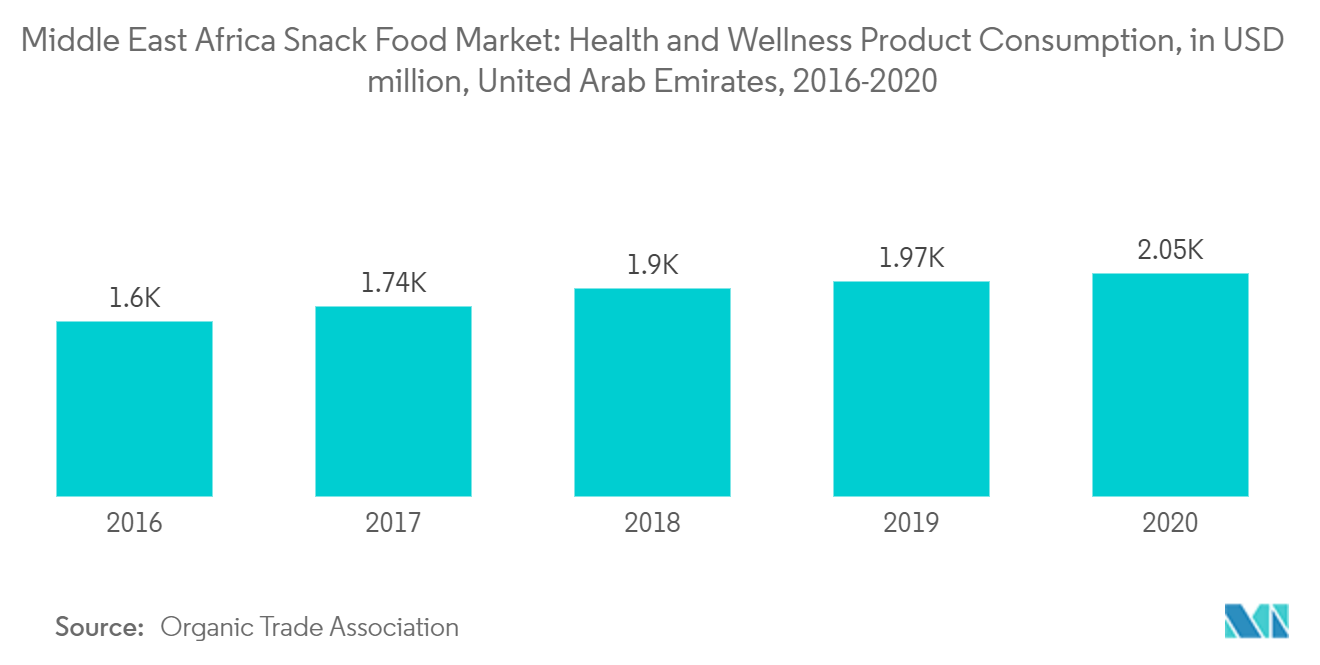
United Arab Emirates is the fastest growing country
The increasing demand for snack food products in the United Arab Emirates is influenced by busy lifestyles, increasing urbanization, and the growing professional middle class. This factor has fueled the demand for convenient and easy-to-prepare meals. In addition, a surge in the ex-pat population in the middle east has greatly influenced the demand for the snack food market. For instance, Qatar and the United Arab Emirates are prominent nations in terms of ex-pat population.
The country's growing ex-pat population is more likely to experiment with new flavors, which is pushing snack manufacturers to offer new and innovative snack options. Some of the popular snacks offered in the region include jalapeno, black truffle, and mustard. The expatriate population in the United Arab Emirates, as per the UN (United Nations) 2020, are 88% of the United Arab Emirates population. Indians form the largest foreign community in the United Arab Emirates, followed by Pakistanis, Bangladeshis, Filipinos, Egyptians, other Asians, Europeans, and Africans.
United Arab Emirates government is also promoting various food and snack producers via events and exhibitions which allow local brands to present their product portfolio to a larger audience. For instance, At the Dubai World Trade Centre, several local entrepreneurs are launching and showcasing a variety of new-to-market items including savory snacks. UAE- based gulf food has Savoury snacks like Toasted corn, Wheat and Flour Tortillas, Nachos, Popcorn and others. All the company products are ISO14001, BRC, IFS, AIB, GMO Free and HALAL (among others) certified firm. Thus, the above factors are driving the market grwoth of snack food market in the country and forsees a strong growth during the forecast period.
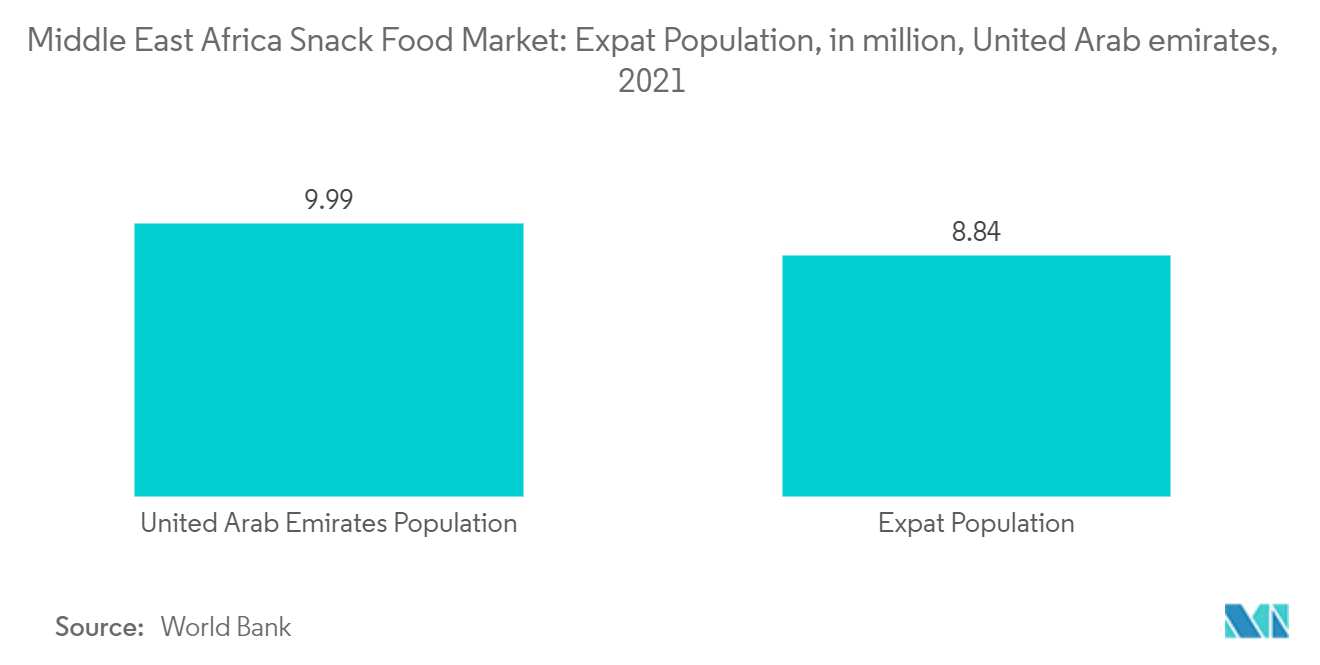
MEA Snack Food Industry Overview
The Middle East and Africa snack food markets are competitive in nature, having a large number of domestic and multinational players competing for market share. Merger and acquisition, expansion, and partnerships, along with new product developments, are the strategic approaches adopted by the leading companies to boost their brand presence among consumers. For instance, In March 2022, Yildiz Holding extended its online operations by introducing the Ülker biscuit brand in the United Arab Emirates (UAE). The products will be sold by the online channel sales company of Yildiz Holding i.e. eStar. Customers can now order Ülker products from eStar in four separate categories: chocolate, biscuits, sweets, and gum, all of which are delivered by Amazon Middle East and North Africa (MENA).
Major players in the market include Unilever, Nestle SA, General Mills, Inc., Kellogg Company, GymaFood Industries LLC, ClifBar & Company, BestfoodCo LLC, Britannia Industries, Mondelez International, and Gellatas Gullon. holding a significant share of the market studied and embarking on business strategies including product innovations, partnerships, strengthening their hold over online and offline marketing, and mergers & acquisitions to expand their visibility and portfolio of offerings, thus, augmenting the growth of the market.
MEA Snack Food Market Leaders
-
Nestle
-
Kellogg's Company
-
General Mills Inc.
-
Unilever
-
PepsiCo
*Disclaimer: Major Players sorted in no particular order
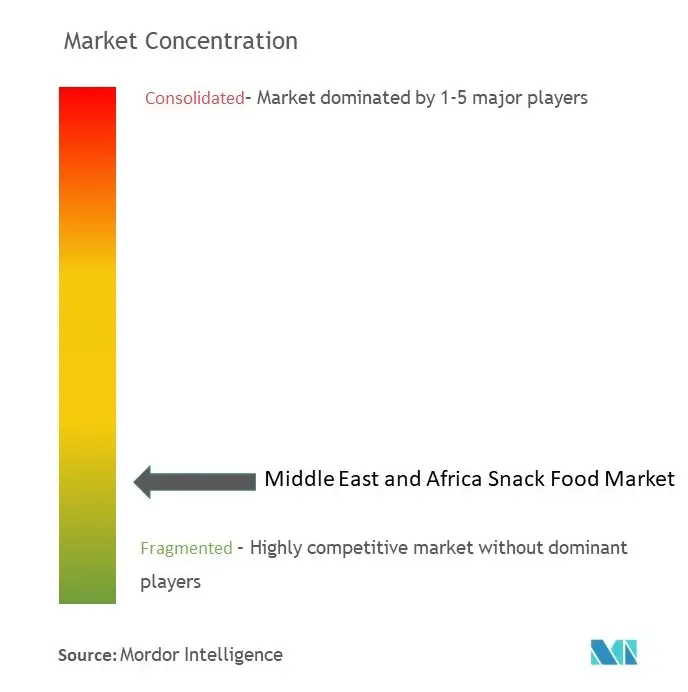
MEA Snack Food Market News
- In October 2021, the TNF Pure Fruit Bar brand launched in the United Arab Emirates. The fruit bars are vegan and vegetarian, gluten-free, dairy-free, and nut-free, and have no preservatives, additives, or colorants. The bars are available in three variants Strawberry, Apricot, and Raspberry.
- In July 2021, Khabib Nurmagomedov an advocate of a healthy diet in the United Arab Emirates launched a premium protein bar under the brand Fitroo. The products come in different flavors including chocolate, banana, vanilla, and cookies.
- In January 2020, PepsiCo, the Frito-Lay and Walkers Crisps maker, acquired a majority shareholding of Senselet Food Processing, an Ethiopian potato crisps company founded by Veris Investments in 2015. Senselet had a leading market position in Ethiopia with its Sun Chips brand, which used locally sourced potatoes.
MEA Snack Food Market Report - Table of Contents
1. INTRODUCTION
- 1.1 Study Assumptions and Market Definition
- 1.2 Scope of the Study
2. RESEARCH METHODOLOGY
3. EXECUTIVE SUMMARY
4. MARKET DYNAMICS
- 4.1 Market Drivers
- 4.2 Market Restraints
-
4.3 Porter's Five Force Analysis
- 4.3.1 Threat of New Entrants
- 4.3.2 Bargaining Power of Buyers/Consumers
- 4.3.3 Bargaining Power of Suppliers
- 4.3.4 Threat of Substitute Products
- 4.3.5 Intensity of Competitive Rivalry
5. MARKET SEGMENTATION
-
5.1 By Type
- 5.1.1 Frozen Snacks
- 5.1.2 Savory Snacks
- 5.1.3 Fruit Snacks
- 5.1.4 Confectionery Snacks
- 5.1.5 Bakery Snacks
- 5.1.6 Others
-
5.2 By Distribution
- 5.2.1 Supermarket & Hypermarkets
- 5.2.2 Convenience stores
- 5.2.3 Online retail Stores
- 5.2.4 Other Distribution Channels
-
5.3 By Geography
- 5.3.1 South Africa
- 5.3.2 Saudi Arabia
- 5.3.3 Rest of Middle East & Africa
6. COMPETITIVE LANDSCAPE
- 6.1 Most Adopted Strategies
- 6.2 Market Share Analysis
-
6.3 Company Profiles
- 6.3.1 Unilever
- 6.3.2 Nestle SA
- 6.3.3 General Mills, Inc.
- 6.3.4 Kellogg Company
- 6.3.5 GymaFood Industries LLC
- 6.3.6 ClifBar & Company
- 6.3.7 BestfoodCo LLC
- 6.3.8 Britannia Industries
- 6.3.9 Mondelez International
- 6.3.10 Gellatas Gullon
- *List Not Exhaustive
7. MARKET OPPORTUNITIES AND FUTURE TRENDS
8. IMPACT OF COVID 19 ON THE MARKET
9. DISCLAIMER
** Subject To AvailablityMEA Snack Food Industry Segmentation
Snack foods are packed with essential nutrients and are often referred to as nutrient-dense snacks. Further, the product scope includes snacks with a low content of saturated fats, added sugar, and sodium. Snacks can be consumed as a simple meal that is quick to cook and eat. The Middle East & Africa snack food market is segmented by type into frozen snacks, savory snacks, fruit snacks, confectionery snacks, bakery snacks, and other types. By distribution channel, the market is segmented into supermarkets and hypermarkets, convenience stores, online retail stores, and other distribution channels. By geography into South Africa, Saudi Arabia, and the Rest of the Middle East & Africa. The report offers market size and forecasts in value (USD million) for the above segments.
| By Type | Frozen Snacks |
| Savory Snacks | |
| Fruit Snacks | |
| Confectionery Snacks | |
| Bakery Snacks | |
| Others | |
| By Distribution | Supermarket & Hypermarkets |
| Convenience stores | |
| Online retail Stores | |
| Other Distribution Channels | |
| By Geography | South Africa |
| Saudi Arabia | |
| Rest of Middle East & Africa |
MEA Snack Food Market Research FAQs
What is the current Middle East & Africa Snack Food Market size?
The Middle East & Africa Snack Food Market is projected to register a CAGR of 4.10% during the forecast period (2024-2029)
Who are the key players in Middle East & Africa Snack Food Market?
Nestle, Kellogg's Company, General Mills Inc., Unilever and PepsiCo are the major companies operating in the Middle East & Africa Snack Food Market.
What years does this Middle East & Africa Snack Food Market cover?
The report covers the Middle East & Africa Snack Food Market historical market size for years: 2019, 2020, 2021, 2022 and 2023. The report also forecasts the Middle East & Africa Snack Food Market size for years: 2024, 2025, 2026, 2027, 2028 and 2029.
MEA Snack Food Industry Report
Statistics for the 2024 MEA Snack Food market share, size and revenue growth rate, created by Mordor Intelligence™ Industry Reports. MEA Snack Food analysis includes a market forecast outlook 2029 and historical overview. Get a sample of this industry analysis as a free report PDF download.



